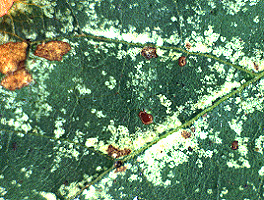
Grape leafhopper, Erythroneura spp.
Several related species comprise this group, but
there
are few differences in their life histories. Unmated adults overwinter
in plant debris in and near the vineyard. Adults are about 3 mm long,
pale
yellow with red, yellow, or black markings. In the first warm days of
spring
the adults become active, feeding on any green foliage before grape
leaves
appear. In May, leafhoppers go to vines and feed but little damage is
done
at this time. After feeding for 2-3 weeks, females oviposit just below
the surface of leaf tissue. Eggs hatch in about two weeks, depending
upon
temperature. Females lay an average of 100 eggs each. Nymphs are pale
and
wingless, with red eyes. They usually remain on the undersides of
leaves
and are quite active, often running sideways. There is a 3-5 week
development
period, and 2-3 generations per season.
Both nymphs and adults suck sap from leaves,
resulting
in pale stippling. With heavy infestations, leaves become yellow or
brown,
and drop. Numbers are highest late in the summer, especially on end
vines
and border rows. Quality (sugar content) and quantity of fruit may be
greatly
reduced. However, high populations are required to reduce fruit
quality.
Researchers in New York have created a conservative provisional
action threshold of five nymphs per leaf before August 1, and
ten
nymphs per leaf thereafter.
This is taken primarily from an extension
bulletin
by D. G. Pfeiffer & P. B. Schultz, entitled "Major Insect and Mite
Pests of Grape in Virginia" (Va. Coop. Ext. Serv. 444-567 (1986))
See the linked fact sheets on grape leafhopper from
California
and Colorado
State.
See monograph
on leafhoppers on grape.
Back to Virginia
Vineyard
page
Back to Virginia
Fruit Page